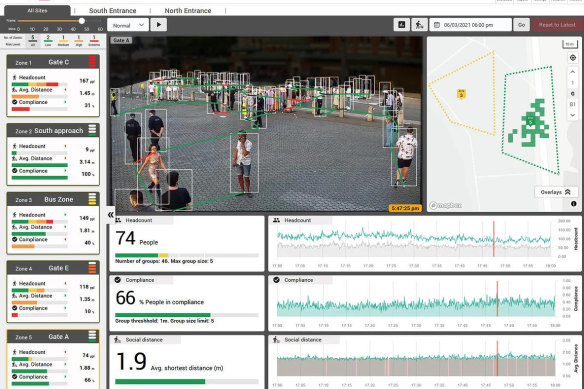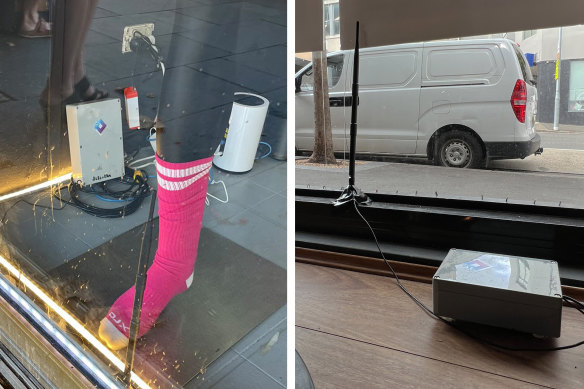Several CCTV cameras with sophisticated data analytics software that monitors crowd mood and density will be temporarily installed along Sydney’s Oxford Street as part of the Mardi Gras Parade on Saturday.
Technology that counts mobile phones by measuring radiofrequency has been separately installed at several shopfronts in Darlinghurst and Surry Hills to count people as part of WorldPride.

It is the first time either technology has been used as part of Mardi Gras and WorldPride, although it has previously been used for Sydney’s New Year’s Eve celebrations and the annual Vivid festival of light.
The sophisticated CCTV software can detect an average mood of a crowd by creating ranks of happy, neutral, sad, and angry – it can also measure the speed of groups walking.
While some of the software’s functions can be disabled, Mardi Gras has decided to use all the capabilities so proactive calls could be made about crowd safety.
At a parade like Mardi Gras, the argument is that knowing simply a headcount, for example, might not provide critical information needed to take action. Instead, knowing the density or mood of a specific area of Oxford Street will allow Mardi Gras to identify if a pinch point is occurring there — which can lead to crowd crush if not addressed — while only knowing the headcount wouldn’t provide that.

The argument by some for using smart CCTV software is that crowds often won’t distribute themselves evenly and safely without intervention – and such technology can help manage that.
Mardi Gras said the company behind the software, Dynamic Crowd Measurement, was only engaged for the parade and would be used to support on-ground staff to “direct people to less crowded zones if areas are becoming too full”.
“The technology helps with managing the safety of the crowd by measuring capacities, allowing operations to zone in on an area that needs immediate response or to plan ahead for where there are areas of growing crowds,” a Mardi Gras spokesperson said.
Mardi Gras pointed to the Seoul Halloween crowd crush that killed 159 people last year as justification for the use of the CCTV software, which it said was “not used for surveillance and does not track or collect any personal information”.
“There is no facial recognition tracking and it cannot track people from one place to another. It provides real-time metrics that snapshot the crowd across the entire route at any given point to inform proactive crowd management decision-making,” the spokesperson said.
“With hundreds of thousands of spectators set to descend on Oxford and Flinders streets, Dynamic Crowd Measurement will be an important tool to help parade operations avoid potential incidents.”
A Sydney Gay and Lesbian Mardi Gras officer will monitor the CCTV software on parade night and “feed specific metrics to police who help direct crowds”, Mardi Gras said. “All data will be handled by the Sydney Gay and Lesbian Mardi Gras team and only provided to event stakeholders including police at specific times on the night when it is relevant for crowd safety decisions.”
While footage will not be recorded, metrics to help with crowd management will be, such as density and speed. The technology doesn’t use City of Sydney CCTV, but temporarily installed cameras.
Mardi Gras said Dynamic Crowd Measurement offered the best solution for Mardi Gras to safely manage crowds.

“There is other technology that can help with crowd management through pinging mobile phones in the area. However, due to the large numbers of crowds expected at [the] parade, phone networks will be unreliable, making it difficult to receive accurate data to make important operational decisions.”
But tech experts the Herald spoke to refuted the claim that mobile pinging technology was unreliable with large crowds. This, they say, is because the technology does not require mobile devices to have any connections to a cell tower.
WorldPride will make use of software known as “radio frequency density” measuring technology, with devices from company Behavioural Analytics used to measure crowds attending “Pride Villages” – mini street festivals that will involve shutting down portions of Crown, Riley and Foley streets to traffic.
On Thursday, The Sydney Morning Herald and The Age observed at least two of the mobile phone tracking boxes installed – at underwear shop Daily Jocks on Oxford Street, and at Ziggy’s Barber Salon on Riley Street.
“Sydney WorldPride are using safety technology that estimates how many people are in an area via pings to mobiles phones,” a Sydney WorldPride spokesperson said. “This technology does not require cameras and the data is not personally identifiable. All that is reported is the amount of mobile phones in the area. Sydney WorldPride are covering the cost of this safety technology.”
NSW Police referred requests to comment on the two technologies to Mardi Gras and WorldPride, but said it had been working with them and a range of government agencies to “provide a safe and secure environment for those attending Mardi Gras Parade”.
“That includes plans to manage traffic and transport, public safety and health and crowd management,” it said. “Police will be deployed from police area commands across the metropolitan area, supported by specialist officers.”
